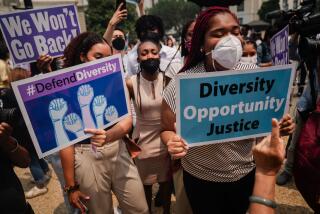Report Details Job-Market Advances
A new study has found that women and minorities made significant progress toward equal opportunity in the work force during the 1970s. But this good news, released earlier in the month by the Potomac Institute Inc. in Washington, D.C., is not without irony. The institute concluded that this progress was in large part due to affirmative action and adoption of affirmative action by private industry--a method for achieving equality that is under fire from the President, attorney general and other Administration officials.
Not only have women and minorities obtained more jobs, but the quality of their jobs has improved, the institute said in its report, written by Herbert Hammerman, a retired private consultant formerly with the Equal Employment Opportunity Commission.
For example, women’s share of the job market rose from 34.4% to 41% during the decade, and the largest increases were in the top three white-collar categories. The proportion of women officials and managers rose from 10.2% to 18.5%, an 81% increase. The number of professionals rose from 24.6% to 37.7%, and technicians from 26.4% to 40.2%.
Black Professionals Increase
Blacks and Latinos experienced similar percentage increases in the higher status jobs along with increases in numbers of workers. Blacks’ share of the job market rose from 10.1% to 11.6%, a 15% increase. At the official/manager level, black participation increased by 104%, although their numbers are still small in this field--4%, up from 1.9% in 1970. The number of black workers in professional and skilled jobs also increased significantly while at the same time black participation in lower-paid labor and service jobs declined. Latinos experienced a 120% increase in participation in management levels, from 1% to 2.2%, while their overall employment participation increased from 3.6% to 5.4%.
The new report is particularly encouraging for women and minorities in that affirmative action was initially very slow to show results. In 1961 President John Kennedy signed the first executive order requiring that private employers holding federal contracts, as well as the federal government itself, to take “affirmative action” to promote equality in employment. Twelve years later, in 1973, the Potomac Institute had found that it was “disquietingly clear that more than a decade of affirmative action policy has yielded woefully inadequate results.”
Ten years later, and with much more precise data, Potomac Institute President Harold C. Fleming wrote in the foreword to the new report: “The gains have been uneven and in most areas parity is still remote. But the trend is unmistakably in the direction of equal opportunity, particularly in the higher positions that were so long closed to the traditional victims of discrimination.”
1970s: Quiet Decade
As the report points out, the 1970s--with high unemployment, economic stagnation and inflation--were not particularly auspicious years to push for job opportunities. Nevertheless, the decade proved to be a time of widespread expansion of equal employment opportunity programs, and the report concludes firmly that there is “no doubt” that the change in the employment climate for women and minorities is a result of affirmative action. One substantial piece of evidence came from an earlier study by the Office of Federal Contract Compliance in the U.S. Department of Labor. In a sampling of 77,000 places of business employing more than 20 million workers, the study found that women and minorities made greater gains in businesses that had federal contracts--where affirmative action is in force--than in non-contractor firms where it is not.
The Reagan Administration’s objection to affirmative action centers on the use of numerical goals--quotas--which can and sometimes have resulted in reverse discrimination against qualified white males. Critics advocate returning to the method of the 1950s, which afforded relief on a case-by-case basis to an individual who could prove that he or she had been a victim of intentional discrimination.
Two Types of Affirmative Action
Opponents of affirmative action have confused the issue, according to Fleming. There are two types of affirmative action. The first, covered by executive order and applying only to federal contractors and the federal government itself, prescribes fair employment goals and forbids the imposition of quotas. The second type of affirmative action was mandated by Congress in Title VII of the Civil Rights Act of 1964, and gives federal courts broad authority to order what they judge appropriate forms of affirmative action, including quotas.
Institute research found that while some companies--American Telephone & Telegraph was one--required judicially enforced consent decrees to make changes, in most instances companies have altered their own employment practices to equalize opportunity and that in fact “most big industry sees it (affirmative action numerical procedure) as an essential management tool.”
The report documents two assumptions about affirmative action, Fleming wrote: “The first is that it has moved our society closer to the democratic goal of equal opportunity. The second is that the gap remaining is too wide to justify relaxing our efforts and abandoning methods of proved effectiveness. If there are flaws in the execution of these methods, then by all means we should correct them. But let us not use them as a pretext for returning to the complacent and unfruitful policies of the past.”
New resource cards listing telephone numbers and addresses of family planning service and women’s health clinics throughout Los Angeles County are available free from the Family Planning Consumer Advocacy Project, a nonprofit organization concerned with public education and disseminating information about family planning. The cards, printed in English and Spanish, are designed to provide the public with concise information. The clinics listed provide women and men with information, care and referrals at little or no cost. Copies may be ordered by sending a stamped, self-addressed envelope to Family Planning Consumer Project, 543 N. Fairfax Ave. 301, Los Angeles 90036.
Reaching out to women interested in political involvement or seeking elective office will be a major goal this year for the California Elected Women’s Assn. for Education and Research, according to its new president, Assemblywoman Marian W. LaFollette (R-Northridge.) La Follette, elected to head the organization at its recent annual meeting in Sacramento, said that a series of meetings will be scheduled for San Francisco, Fresno and San Diego. CEWAER is an 11-year-old, nonpartisan, statewide organization of elected, appointed and interested women and men that focuses on developing women’s skills toward achieving elective offices.
More to Read
Inside the business of entertainment
The Wide Shot brings you news, analysis and insights on everything from streaming wars to production — and what it all means for the future.
You may occasionally receive promotional content from the Los Angeles Times.










